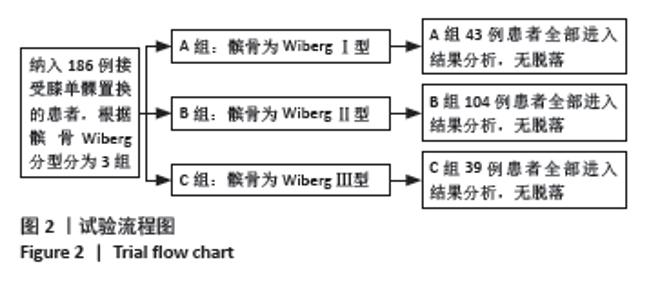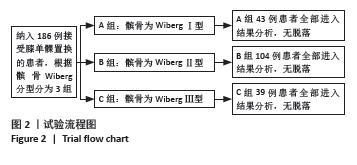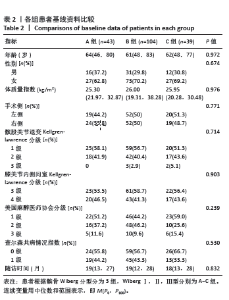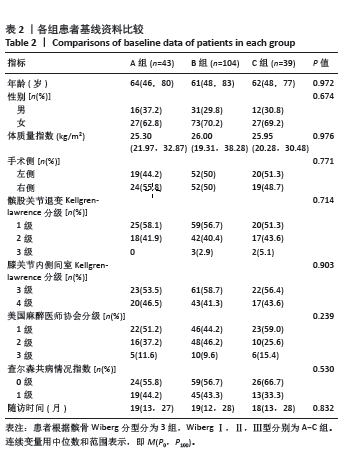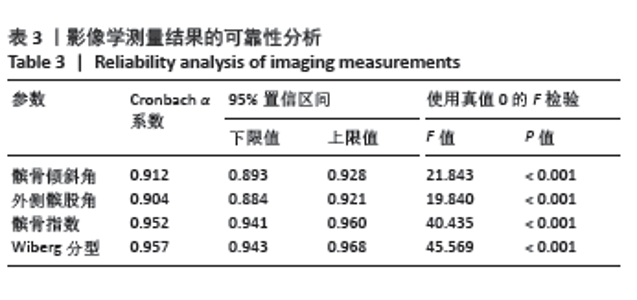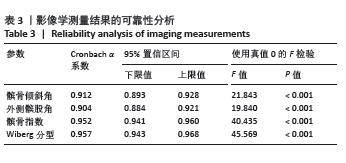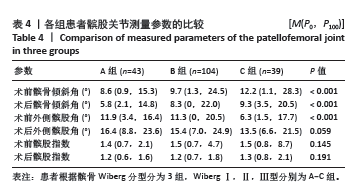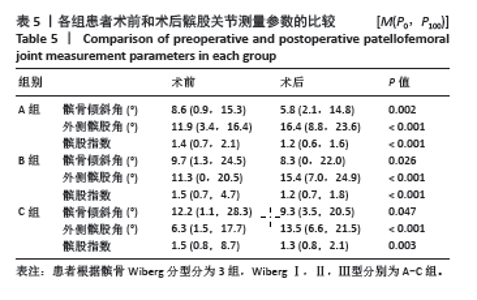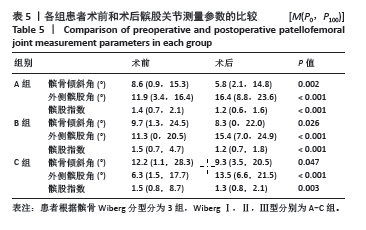Chinese Journal of Tissue Engineering Research ›› 2025, Vol. 29 ›› Issue (27): 5826-5832.doi: 10.12307/2025.803
Previous Articles Next Articles
Effect of patellar morphology on functional recovery and patellofemoral joint alignment after unicompartmental knee arthroplasty
Sun Yingjin, Liu Ning, Huang Long, Feng Shuo, Chen Xiangyang
- Affiliated Hospital of Xuzhou Medical University, Xuzhou 221000, Jiangsu Province, China
-
Received:2024-04-15Accepted:2024-06-21Online:2025-09-28Published:2025-03-05 -
Contact:Chen Xiangyang, MD, Chief physician, Affiliated Hospital of Xuzhou Medical University, Xuzhou 221000, Jiangsu Province, China -
About author:Sun Yingjin, Master candidate, Affiliated Hospital of Xuzhou Medical University, Xuzhou 221000, Jiangsu Province, China -
Supported by:Medical New Technology Project of Affiliated Hospital of Xuzhou Medical University, No. 2023301010 (to CXY)
CLC Number:
Cite this article
Sun Yingjin, Liu Ning, Huang Long, Feng Shuo, Chen Xiangyang. Effect of patellar morphology on functional recovery and patellofemoral joint alignment after unicompartmental knee arthroplasty[J]. Chinese Journal of Tissue Engineering Research, 2025, 29(27): 5826-5832.
share this article
Add to citation manager EndNote|Reference Manager|ProCite|BibTeX|RefWorks
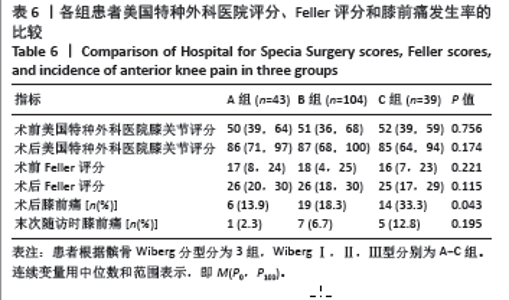
2.6 临床评价结果 3组患者术前和末次随访时美国特种外科医院评分和Feller评分相比差异均无显著性意义(P > 0.05)。术后至末次随访期间共计20.1%(39/186)的患者出现过膝前痛,C组明显高于A组(P=0.021);A组和B组以及B组和C组之间差异均无显著性意义(P > 0.05)。在末次随访时共计7.0%(13/186)的患者仍发生膝前痛,3组之间差异无显著性意义(P < 0.05)。见表6。 2.7 术后并发症 在随访期间,各组患者均未发生感染、髌骨坏死、假体周围骨折、假体松动以及垫片脱位等并发症。3组患者截止到随访结束时未发生与植入物相关的不良反应,植入物生物相容性良好。"
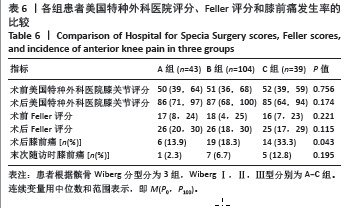
| [1] JENNY JY. Minimally invasive unicompartmental knee arthroplasty. Eur J Orthop Surg Traumatol. 2018;28(5):793-797. [2] GE J, HERNIGOU P, GUO W, et al. Minimally invasive small incision surgical technique for unicompartmental knee arthroplasty. Int Orthop. 2023;47(11):2717-2725. [3] AL-DADAH O, HING C. Unicompartmental Knee Arthroplasty: General trends of clinical practice. Knee. 2023;41:A1-A2. [4] TILLE E, BEYER F, AUERBACH K, et al. Better short-term function after unicompartmental compared to total knee arthroplasty. BMC Musculoskelet Disord. 2021;22(1):326. [5] KNIFSUND J, NIINIMAKI T, NURMI H, et al. Functional results of total-knee arthroplasty versus medial unicompartmental arthroplasty: two-year results of a randomised, assessor-blinded multicentre trial. BMJ Open. 2021;11(6):e046731. [6] HEEKIN RD, FOKIN AA. Incidence of bicompartmental osteoarthritis in patients undergoing total and unicompartmental knee arthroplasty: is the time ripe for a less radical treatment. J Knee Surg. 2014;27(1): 77-81. [7] PEREIRA PM, BAPTISTA JS, CONCEIÇÃO F, et al. Patellofemoral Pain Syndrome Risk Associated with Squats: A Systematic Review. Int J Environ Res Public Health. 2022;19(15):9241. [8] ARTZ NJ, HASSABALLA MA, ROBINSON JR, et al. Patient Reported Kneeling Ability in Fixed and Mobile Bearing Knee Arthroplasty. J Arthroplasty. 2015;30(12):2159-2163. [9] FENG H, FENG ML, CHENG JB, et al. Meta-analysis of factors influencing anterior knee pain after total knee arthroplasty. World J Orthop. 2024; 15(2):180-191. [10] LAUBACH M, HELLMANN JT, DIRRICHS T, et al. Anterior knee pain after total knee arthroplasty: A multifactorial analysis. J Orthop Surg (Hong Kong). 2020;28(2):2309499020918947. [11] SILJANDER B, TOMPKINS M, MARTINEZ-CANO JP. A Review of the Lateral Patellofemoral Joint: Anatomy, Biomechanics, and Surgical Procedures. J Am Acad Orthop Surg Glob Res Rev. 2022;6(7):e21.00255. [12] TAN SHS, IBRAHIM MM, LEE ZJ, et al. Patellar tracking should be taken into account when measuring radiographic parameters for recurrent patellar instability. Knee Surg Sports Traumatol Arthrosc. 2018;26(12): 3593-3600. [13] CHEN J, YE Z, WU C, et al. Sulcus depth, congruence angle, Wiberg index, TT-TG distance, and CDI are strong predictors of recurrent patellar dislocation. Knee Surg Sports Traumatol Arthrosc. 2023;31(7): 2906-2916. [14] PANNI AS, CERCIELLO S, MAFFULLI N, et al. Patellar shape can be a predisposing factor in patellar instability. Knee Surg Sports Traumatol Arthrosc. 2011;19(4):663-670. [15] TAKAHASHI A, SANO H, OHNUMA M, et al. Patellar morphology and femoral component geometry influence patellofemoral contact stress in total knee arthroplasty without patellar resurfacing. Knee Surg Sports Traumatol Arthrosc. 2012;20(9):1787-1795. [16] BUTNARU M, SIGONNEY G, MÜLLER JH, et al. Wiberg Type III patellae and J-sign during extension compromise outcomes of total knee arthroplasty without patellar resurfacing. Knee. 2020;27(3): 787-794. [17] OTTO A, TSCHOLL PM, PÄÄSUKE R, et al. Neither lateral patellar facet nor patellar size are altered in patellofemoral unstable patients: a comparative magnetic resonance imaging analysis. Knee Surg Sports Traumatol Arthrosc. 2020;28(4):1064-1071. [18] 王运杰, 陈歌, 程宇翔, 等. 基于Wiberg分型探讨髌骨形态对髌股关节病变病人全膝关节置换术疗效的影响[J].骨科,2024,15(1): 12-17. [19] WIBEEG G. Roentgenographs and Anatomic Studies on the Femoropatellar Joint: With Special Reference to Chondromalacia Patellae. Acta Orthop Scand. 1941;12(1-4):319-410. [20] BARBOSA RM, DA SILVA MV, MACEDO CS, et al. Imaging evaluation of patellofemoral joint instability: a review. Knee Surg Relat Res. 2023; 35(1):7. [21] FELLER JA, BARTLETT RJ, LANG DM. Patellar resurfacing versus retention in total knee arthroplasty. J Bone Joint Surg Br. 1996;78(2): 226-228. [22] NARIN S, UNVER B, BAKIRHAN S, et al. Cross-cultural adaptation, reliability and validity of the Turkish version of the Hospital for Special Surgery (HSS) Knee Score. Mult Scler Relat Disord. 2014;48(3): 241-248. [23] 中国髌股关节骨关节炎诊疗指南(2020年版)[J]. 中华骨科杂志, 2020,40(18):1227-1234. [24] WANG Z, NI J, MAO Z, et al. Survival of lateral unicompartmental knee arthroplasty at short-, mid-, and long-term follow-up: a systematic review and meta-analysis. ANZ J Surg. 2023;93(4):980-988. [25] BAYOUMI T, VAN DER LIST JP, RUDERMAN LV, et al. Successful same-day discharge in 88% of patients after unicompartmental knee arthroplasty: a systematic review and meta-analysis. Knee Surg Sports Traumatol Arthrosc. 2023;31(3):946-962. [26] CAO L, SUN K, YANG H, et al. Influence of Patellar Morphology Classified by Wiberg Classification on Knee Joint Function and Patellofemoral Tracking After Total Knee Arthroplasty Without Patellar Resurfacing. J Arthroplasty. 2021;36(9):3148-3153. [27] 杨冠杰, 刘磊, 徐石庄, 等. Wiberg分型对保留髌骨TKA术后髌骨轨迹及功能的影响[J]. 实用骨科杂志,2019,25(10):883-887+902. [28] 薛华明, 马童, 文涛, 等. 再议膝关节单髁置换术的适应证[J]. 中华医学杂志,2024,104(5):319-324. [29] REIDER B, MARSHALL JL, KOSLIN B, et al. The anterior aspect of the knee joint. J Bone Joint Surg Am. 1981;63(3):351-356. [30] 何志勇, 吴海山, 狄正林, 等. 国人髌骨形态学研究及其在髌骨假体设计中的意义[J]. 中国骨与关节损伤杂志,2006(8):611-613. [31] 董佩龙, 唐晓波, 王健. 髌骨修整在人工全膝关节成形术中的应用[J]. 中国骨与关节外科,2014,7(2):157-159. [32] 胡军林, 黄正, 欧阳桂林, 等. 髌骨成形术对类风湿关节炎全膝关节置换术后髌骨轨迹和膝前痛的影响[J]. 生物医学工程研究,2011, 30(3):184-187. [33] 石岩, 肖德明, 崔文岗, 等. 髌骨脱位与髌骨Wiberg形态学分型回顾性研究[J]. 国际骨科学杂志,2013,34(4):302-304+309. [34] QIU L, LI J, SHENG B, et al. Patellar shape is associated with femoral trochlear morphology in individuals with mature skeletal development. BMC Musculoskelet Disord. 2022;23(1):56. [35] ZHAO G, LIU Y, YUAN B, et al. Arthroscopic patelloplasty and circumpatellar denervation for the treatment of patellofemoral osteoarthritis. Chin Med J. 2015;128(1):79-84. [36] 甘伟伟, 谢贵杰, 周盛涛, 等. 髌周部分去极化技术在膝关节单髁置换术中的应用[J]. 暨南大学学报(自然科学与医学版),2023, 44(6):619-625. [37] 郭宗磊, 王业华, 刘广銮. 膝关节旋转与髌骨不稳[J]. 中国组织工程研究,2023,27(13):2099-2103. [38] WHEATLEY MGA, CLOUTHIER AL, THELEN DG, et al. Patella Apex Influences Patellar Ligament Forces and Ratio. J Biomech Eng. 2021; 143(8):081014. [39] FUKUI N, NAKAGAWA T, MURAKAMI S, et al. A modified system of stress radiography for patellofemoral instability. J Bone Joint Surg Br. 2003;85(8):1128-1133. [40] 利进琴, 曾燕文, 谭珊玲. 膝关节不同屈曲状态下MR参数测量对髌股关节不稳的诊断价值[J]. 影像研究与医学应用,2020,4(13): 17-19. |
| [1] | Ma Chi, Wang Ning, Chen Yong, Wei Zhihan, Liu Fengji, Piao Chengzhe. Application of 3D-printing patient-specific instruments combined with customized locking plate in opening wedge high tibial osteotomy [J]. Chinese Journal of Tissue Engineering Research, 2025, 29(9): 1863-1869. |
| [2] | Sun Yundi, Cheng Lulu, Wan Haili, Chang Ying, Xiong Wenjuan, Xia Yuan. Effect of neuromuscular exercise for knee osteoarthritis pain and function: a meta-analysis [J]. Chinese Journal of Tissue Engineering Research, 2025, 29(9): 1945-1952. |
| [3] | Wang Peiguang, Zhang Xiaowen, Mai Meisi, Li Luqian, Huang Hao. Generalized equation estimation of the therapeutic effect of floating needle therapy combined with acupoint embedding on different stages of human knee osteoarthritis [J]. Chinese Journal of Tissue Engineering Research, 2025, 29(8): 1565-1571. |
| [4] | He Guanghui, Yuan Jie, Ke Yanqin, Qiu Xiaoting, Zhang Xiaoling. Hemin regulates mitochondrial pathway of oxidative stress in mouse chondrocytes [J]. Chinese Journal of Tissue Engineering Research, 2025, 29(6): 1183-1191. |
| [5] | Ma Haoyu, Qiao Hongchao, Hao Qianqian, Shi Dongbo. Causal effects of different exercise intensities on the risk of osteoarthritis [J]. Chinese Journal of Tissue Engineering Research, 2025, 29(6): 1305-1311. |
| [6] | Wu Guangtao, Qin Gang, He Kaiyi, Fan Yidong, Li Weicai, Zhu Baogang, Cao Ying . Causal relationship between immune cells and knee osteoarthritis: a two-sample bi-directional Mendelian randomization analysis [J]. Chinese Journal of Tissue Engineering Research, 2025, 29(5): 1081-1090. |
| [7] | Li Jia, Liu Qianru, Xing Mengnan, Chen Bo, Jiao Wei, Meng Zhaoxiang. A network meta-analysis on therapeutic effect of different types of exercise on knee osteoarthritis patients [J]. Chinese Journal of Tissue Engineering Research, 2025, 29(3): 609-616. |
| [8] | Liu Mengfei, Chen Gang, Shi Yihan, Zeng Lin, Jiang Kan, Yilihamujiang•Wusiman. Finite element analysis of optimization of femoral prosthesis implantation position in unicompartmental knee arthroplasty in osteoporotic patients [J]. Chinese Journal of Tissue Engineering Research, 2025, 29(3): 464-470. |
| [9] | Shi Lei, Shi Song, Lu Yue, Tao Ran, Ma Hongdong. Comparison of unicondylar knee arthroplasty and high tibial osteotomy in treatment of medial knee osteoarthritis [J]. Chinese Journal of Tissue Engineering Research, 2025, 29(3): 503-509. |
| [10] | Zhang Yunyi, Liu Songtao, Xie Shaodong, Zhu Haifeng, Qian Guifeng, Huo Ming, Zhou Jie, Deng Zixuan. Platelet rich plasma versus hyaluronic acid in treatment of knee osteoarthritis: an overview of systematic reviews [J]. Chinese Journal of Tissue Engineering Research, 2025, 29(28): 6138-6145. |
| [11] | Wei Changqiang, Yu Hongjian, Liu Ningning, Zhang Yinxiao. Effect of line adjustment area of lower limbs on knee joint function and kinematics after high tibial osteotomy [J]. Chinese Journal of Tissue Engineering Research, 2025, 29(27): 5743-5749. |
| [12] | Li Yongjie, Liu Mengling, Zhang Dakuan, Fu Shenyu, Liu Hongju. Effect of unilateral knee osteoarthritis on gait dynamics and muscle activation asymmetry in elderly women [J]. Chinese Journal of Tissue Engineering Research, 2025, 29(27): 5750-5756. |
| [13] | Ding Yuan, Gong Jianbao, Zhang Jie, Qiao Yuan, Xu Wenlong. Characteristic analysis of isometric muscle strength of knee joint in patients after unicompartmental knee arthroplasty [J]. Chinese Journal of Tissue Engineering Research, 2025, 29(27): 5833-5838. |
| [14] | Shaban Amiri Nzelekela, Yang Lianbo, Li Peng. Objective accuracy of six degree of freedom gait analysis system in evaluating the severity of knee osteoarthritis [J]. Chinese Journal of Tissue Engineering Research, 2025, 29(27): 5890-5896. |
| [15] | Sun Hailiang, Pang Jian, Shi Wanzhong, Shi Ying. Protective effect of Huaizhen Yanggan Capsule on knee osteoarthritis induced by sodium iodoacetate in model mice [J]. Chinese Journal of Tissue Engineering Research, 2025, 29(26): 5579-5587. |
| Viewed | ||||||
|
Full text |
|
|||||
|
Abstract |
|
|||||
